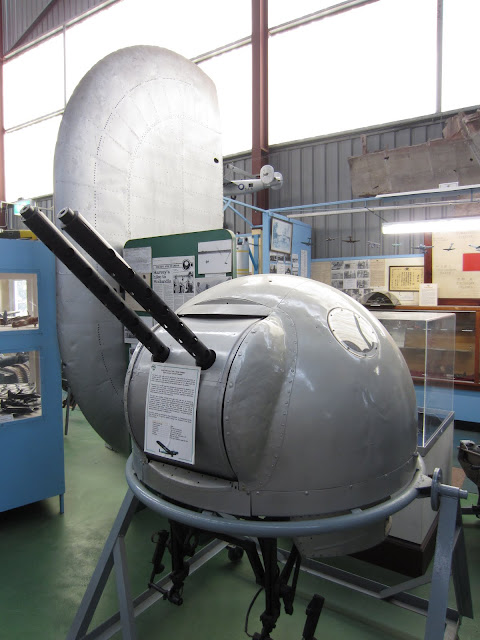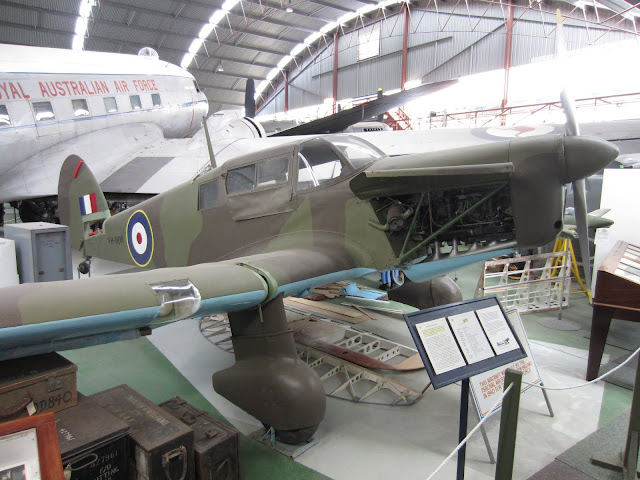
I visited the Royal Australian Airforce Museum in Bullcreek in 2012; my first visit since I was a kid in the late 1970s. I think the museum has doubled in size to two halls since those days.

I arrived fairly late - just before 3pm. My vehicle of choice on this visit was my 1964 IWL Troll scooter from East Germany. The museum shuts at 4pm. http://www.raafawa.org.au/museum/index.html

Consolidated PBY Catalina. In 1943 the US Navy's Catalina Patrol Wing No 10 established a naval base at Matilda Bay. There was a proposal recently to establish a museum on the site which would display this Catalina. http://www.archives.uwa.edu.au/information_about/university_archives2/fact_sheet_index/the_catalina_base

Waist gunner/observer blister

Rear gunner position

1939 Commonwealth Aircraft Corporation CA-6 Wackett. The Wackett was designed as a replacement to the aging Tiger Moth trainer.


1931 De Havilland Tiger Moth


1936 De Havilland Moth Minor, De Havilland's proposed monoplane replacement for the Tiger Moth trainer. Surprisingly, despite being constantly 'replaced' by more modern aircraft, the Tiger Moth remained the RAF and Commonwealth airforces' favourite training aircraft. They were such a delightful and forgiving aircraft to learn on that they continued in operation well after they should have been obsolete.

A replica of the 1909 Santos-Dumont Demoiselle built in 1960 for the film 'Those Magnificent Men in their Flying Machines.' Alberto Santos-Dumont was a Brazilian-born pioneer of aviation who built a number of airships and aircraft in France. http://smithsonianeducation.org/scitech/impacto/graphic/aviation/alberto.html

A replica of a 1921 Bristol Tourer

1933 Flying Flea homebuilt aircraft.

A replica of a 1917 Sopwith Camel.

Overview of the second hall

English Electric Canberra bomber. The Canberra first went into service with the RAF in 1949. This example was built under license in Australia by the Government Aircraft Factory in 1955. The Canberra was to be the backbone of Australia's bomber force from the mid 50s to the early 1980s. This one was donated to the museum in 1983.

Aermacchi MB-326H trainer. The Italian Macchi enjoyed a long career with the RAAF as their primary jet trainer from the 1960s to 2002. This one was based at Pearce Airbase north of Perth. They were a very popular aircraft and often performed aerobatic flights over the city. Given our government these days is so beholden to the US it is inconceivable that they would ever again consider purchasing military hardware from a non-US supplier.

De Havilland Vampire. Originally built in 1945, the Vampire was the first British fighter jet built, but was narrowly beaten into active service by the Gloster Meteor. The RAAF kept them in operation until the 1970s, first as a fighter and then as a trainer. This example was built in Australia under license, served at Pearce Airbase and was donated to the museum in 1970.

The Vampire's twin boom tail is overshadowed by the Lancaster's twin tail.

The Douglas Dakota (DC3) military transport. The DC3 was first released as a civilian airliner in 1931. It was pressed into military service in 1941 when the US entered the Second World War. The DC3 was such a robust and reliable aircraft that it continued in service way after it should have been considered obsolete. The last RAAF Dakota wasn't retired until 1999.

A late model 1945 Supermarine Spitfire Mark 22. The Spitfire entered production in 1938 and fought with distinction during the Battle of Britain. It became one of the most famous fighters of the Second World War. Late model Spitfires like this one remained in service in Australia until 1953, when they were replaced with jet fighters like the Vampire and Gloster Meteor.

1944 CAC Wirraway all purpose aircraft and trainer. The Wirraway was an Australian built version of the US T-6 Texan. They were used by the RAAF during the Second World War as light bombers and ground attack aircraft. They were used after war until 1959 as a training aircraft when they were replaced by the Macchi.

This aeroplane was retired in the 1959 and was donated to the Midland Technical School where it was worked on by apprentices. As it sat in the open its condition deteriorated before it was donated to the museum in 1973. I was five year's old but can still remember clearly standing on the front lawn of my parents house watching the Wirraway being airlifted from Midland to Bullcreek underneath a helicopter. Footage of the airlift was also shown on TV that night. It took several years to restore the plane to this condition.

Here is a photo of the Wirraway as it was at Midland Technical School.

A photograph of the airlift. Both these photos come from Geoff Goodall's excellent site: https://www.goodall.com.au/photographs/wrecks-relics/wrecksnrelics.html

Remote ball turret from an Avro Lincoln. The Lincoln was an improved Lancaster that was used by the Australian Navy in the 1950s.

Avro Anson "The Islander." This Avro Anson was used for decades as an airliner between Perth and Rottnest Island, just off the coast near Fremantle. See link https://www.raafawa.org.au/museum/wa-aviation-history/woods-airways

Cockpit of "The Islander."


The Avro Anson is one of my favourite inter-war era planes. It was introduced in 1935 as a civilian airliner but with the advent of the Second World War was converted to military use. They were used as military transports, trainers, coastal patrol aircraft and general reconnaissance. After the war they were sold of for civilian use again. This aeroplane was used by the Royal Flying Doctor service as an air ambulance until it was retired in 1962. https://www.goodall.com.au/photographs/ansons/ansons.html

Like most aeroplanes of its era the Anson was a mixed construction. The wings were built of glued wooden framework covered by riveted aluminum panels. The fuselage was a tube metal framework with aluminum panels at the front and doped canvas rear. After several decades in the air the wood and fabric components of the plane deteriorated and all the surviving planes were eventually declared no longer airworthy and scrapped. Quite a lot were saved and exist in museums around the world, mostly converted back to their wartime spec.

A 1940 Percival Proctor. The elegant Proctor was introduced as general purpose / trainer to replace the aging Tiger Moth biplane. This aircraft used by the RAF and retired in 1955. It was sold in Australia as a civilian aircraft, but, as with the Anson, by 1962 its wooden wings had deteriorated to the point the aircraft was no longer airworthy. The plane was retired and donated to Bunbury Technical School. The museum acquired the plane in 1972 and completed its restoration in 2000.

The pride of the collection is this 1945 Avro Lancaster Mk VII. This aeroplane was built right at the end of the Second World War and did not see active service. It was sold off to the French Navy who converted it for maritime reconnaissance in 1951. It was retired in 1962 and obtained by the museum. For many years it was displayed at Perth Airport before being moved to the museum. I can vividly remember seeing the plane as a child in the days when you could actually go inside the fuselage. The plane has been thoroughly restored since those days though. You can take a tour that allows you to go aboard.

A photo of the Lancaster as it was displayed at the Perth Airport. It was moved to the museum in 1979. https://www.goodall.com.au/photographs/perth-airport/70sperthairport.html




The Lancaster is on display in the second hall.


Here is a link to an excellent site of photos of derelict military aircraft. Some of the aircraft in the collection are shown here in the condition they were in before saved by the museum and restored.
https://www.goodall.com.au/photographs/wrecks-relics/wrecksnrelics.html


































